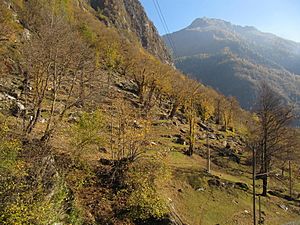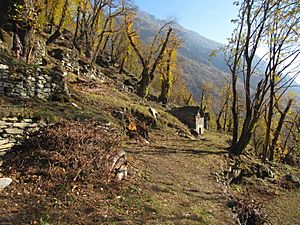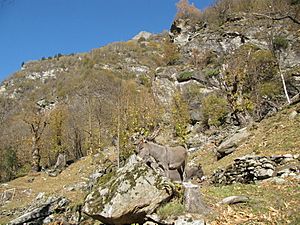Chestnut orchard facts for kids
A chestnut orchard is a special kind of farm where many chestnut trees grow together. These trees are usually planted by people, not wild. They are grown mainly for their tasty fruit, the chestnuts! In these orchards, farmers often grow other things too, like grains or hay. Sometimes, animals like cows or sheep also graze there.
These orchards are very traditional in places like Ticino in Switzerland and Northern Italy. People there call them "selva castanile." You can also find similar orchards in other Mediterranean countries, such as France, Greece, Portugal, and Spain.
Contents
The Story of Chestnut Orchards
Chestnut trees were once known as the "bread tree." This is because their fruit, chestnuts, were a super important food. They were common in Southern Europe and very healthy. Besides fruit, chestnut trees gave people wood, leaves, and even helped make honey. For mountain people, these trees were vital for survival. Some even called it the "Chestnut Civilization."
Even in the Middle Ages, people knew how important chestnuts were. They were especially helpful when trade or travel was difficult. Mountain communities relied on chestnuts for their food supply.
After the Middle Ages, in parts of Italy and Ticino, people focused on growing chestnuts. This happened in areas where other farming, fishing, or trade was hard. Chestnut trees can grow even on less fertile land. This left the best land for other crops like grains.
At the start of the 1900s, chestnuts were still the main food for mountain people. They ate them for most of the year. A great thing about chestnuts was that you could dry them. This meant they could be stored until the next harvest. They were a lifesaver if food was scarce. Around 1919, one expert thought people ate about 100 kg of chestnuts each year! This meant each person needed two or more chestnut trees.
Chestnuts were so important they were part of many traditions. People gave them as wedding gifts or for funerals. They were even used to pay taxes or support widows.
Why Chestnut Orchards Declined
The importance of chestnuts began to fade in the 1800s. Several things caused this decline:
- People started eating more corn and potatoes instead of chestnuts.
- Farming methods improved, making other crops easier to grow.
- New roads and railways made it easier to get food from far away.
- Many rural people moved to cities for factory jobs.
- Old chestnut trees were cut down for their wood and bark. This wood was used to make tannin for tanning leather.
Later, two major diseases made things even worse. These were the Ink disease and the Chestnut blight. Orchards were slowly left empty. It became too hard to maintain them, and they produced less fruit. Other wild trees grew into the orchards. This reduced the number of chestnut trees. It also made the remaining trees weaker.
Also, chestnuts became less popular as a food. Today, they are mostly used for cakes or as a side dish. People also enjoy them as roasted snacks. Now, people eat only about 1 kg of chestnuts per person each year.
Chestnut Orchards Today
Since the 1990s, people have become interested in chestnut orchards again. Local communities and governments started restoring abandoned orchards. They wanted to bring back old traditions and cultural values. They also wanted to improve the look of the countryside. Some hoped to create new jobs and tourism in rural areas.
People also wanted to rediscover chestnuts as a healthy, natural food. Chestnuts are easy to use and can be part of organic and traditional cooking. Since then, many orchards in Ticino and the Italian Grisons have been restored. Plans are now in place for their long-term, sustainable care.
What is Agroforestry?
Agroforestry is a special way of farming. It means growing trees and crops together on the same land. In chestnut orchards, the trees are the most important part. So, this system is called "high-value tree agroforestry."
A chestnut orchard can have three levels of production:
- First level: The chestnut trees themselves. They produce fruit, leaves for animal food, and wood.
- Second level: Other crops grown under the trees. This could be grains, mushrooms, or hay.
- Third level: Animals that graze under the trees. When animals graze, it's called a silvopastoral system.
Silvopastoral Systems
A silvopastoral system is a type of agroforestry. Here, one of the three levels is a pasture for farm animals. For example, in northwest Spain, chestnut orchards are often used to raise pigs. The pigs eat chestnuts that fall from the trees.
What Do Chestnut Orchards Produce?
Traditional chestnut orchards are very useful. They offer many different products. These include chestnuts, animal products, and even help the environment. For example, they protect the soil from washing away.
The trees give us chestnuts, which are very nutritious. Their leaves can be used as food for animals or as natural fertilizer. The flowers help bees make honey. Chestnut wood is also valuable. It looks nice and lasts a long time, even in bad weather.
Chestnut orchards are also good places to find mushrooms. You can also grow berry bushes there. In Ticino, sheep and goats often graze in these orchards. In Spain, pigs graze and eat fallen chestnuts. These systems also give animals shelter from the weather.
As a silvopastoral system, chestnut orchards offer many benefits. These include good things for nature, the economy, and society.
Economic Benefits
Chestnut orchards have good potential to make money. This is because they produce many high-quality products. After a long time of decline, the market for chestnut products is growing again. People want more natural products. New ways to process chestnuts also help.
Traditional products, once seen as food for poorer people, are now popular. People in many developed countries see them as natural and eco-friendly. However, new technology is needed. This helps with storing chestnuts and dealing with different harvest sizes. This way, orchards can take advantage of new market chances.
Better harvesting and processing methods have opened new doors. Traditional chestnut products can now be kept fresh and sold better. Chestnut orchards also offer both things you can sell (food, wood, animal feed) and things that help everyone (healthy soil, clean water and air, more wildlife, beautiful scenery). This helps rural areas have a stronger economy. It also protects the environment. Governments are even supporting chestnut projects. For example, a program called Agenda 2000 helps European farmers grow chestnuts. This helps them find new ways to make money.
How Chestnut Orchards Help Nature
Chestnut orchards are good for the soil. The deep roots of chestnut trees and other plants help keep the soil strong. This means the soil holds water better. It also stops soil from washing away. Deep roots can also absorb nutrients that might otherwise sink too deep for other plants.
These systems also help reduce greenhouse gases. First, the plants and soil in these systems lose less carbon. Second, in silvopastoral systems, grazing animals produce less methane. Also, these systems can produce more meat from the same area. This helps reduce greenhouse gas emissions even more.
Chestnut orchards are very good at storing carbon. They store more carbon than just pastures or crop fields. This three-level system can play a big role in fighting climate change.
Finally, chestnut orchards increase the number of different living things. More plants grow because of the trees and shrubs. These plants then provide homes for insects and other animals. For example, more birds are found in these systems than in just pastures or woodlands. Also, the number of earthworms and other soil creatures increases. This is good for the soil.
Social Value
Many European countries are now funding projects to restore chestnut orchards. This is because these orchards help keep landscapes beautiful. They also preserve the traditional heritage of the countryside. Even though they were forgotten for a while, people still see chestnuts as local and traditional. So, they are well-liked.
Chestnut orchards are also being restored for their beauty. In many places, growing chestnuts helps bring in tourists. This creates a good balance between farming and tourism.
Challenges for Chestnut Orchards
Diseases
In the past, two main diseases caused chestnut production to drop:
- Ink disease, caused by Phytophthora cambivora.
- Chestnut blight, caused by Cryphonectria parasitica.
The Chestnut blight is now mostly under control. This is thanks to a natural, weaker form of the disease that spreads on its own. The Ink disease is less common today. But sometimes, whole orchards can still die suddenly in certain areas.
A newer problem is the Chestnut gall wasp. This insect makes bumps on the trees. But scientists are fighting it by introducing its natural enemy, Torymus sinensis, from China.
Another fungus, Mycosphaerella maculiformis, attacks the leaves. The leaves wilt and fall off early. The trees don't die, but they become weaker and produce fewer chestnuts.
Climate Change
Today, the biggest challenge is climate change. We are seeing more very hot and dry summers. We also have more very cold and wet summers. In these conditions, diseases and pests are more common. This puts good chestnut harvests at risk. For example, in 2003, extreme heat made tree leaves wilt in July and August. This led to a very small chestnut harvest.
Other Challenges
Growing chestnuts with other crops can sometimes cause problems. The large chestnut tree canopies might block too much sunlight for the crops below. Also, managing such a complex system can mean more work for farmers. So, these systems need careful planning before they are set up.




